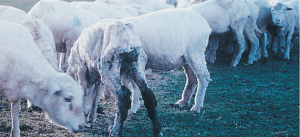
An OJD-affected sheep among healthy animals.
AUSTRALIA’S sheep producers have six weeks to tell their leaders whether the National Ovine Johne’s Disease Management Plan should continue, be changed or dropped.
With the 2013-2018 National Ovine Johne’s Disease Management Plan due to finish this year, WoolProducers Australia and Sheep Producers Australia are seeking feedback from the sheep and wool industry on the future management of the sheep wasting disease.
The bodies have developed a discussion paper outlining the review process and are seeking feedback from interested stakeholders. Industry stakeholders have until close of business on March 12 2018 to provide feedback.
The discussion paper and further information is available via https://www.animalhealthaustralia.com.au/ojd-review/ An online producer survey is also available at: www.surveymonkey.com/r/ojdplan
The current NOJDMP was prepared by WPA and SPA after consultation with industry in 2012-13. The plan is managed by Animal Health Australia on behalf of the bodies.
Last year Animal Health Australia said 10 percent of properties that had sheep lines inspected at abattoirs in 2007 returned positive results for OJD. In 2016, this rate dropped to 3.4pc. Sheep Central has requested the latest OJD abattoir monitoring data from AHA.
Two options proposed for future OJD management
SPA animal health and welfare manager, Stephen Crisp, said there are currently two broad options which will be considered in the review process.
“The two options include: the current NOJDMP will cease, however the tools and strategies for managing OJD will continue to be available through the Sheep Health Project and producers will be encouraged to maintain biosecurity for OJD and other diseases and conditions; or a revised OJD framework will be developed based on the current plan and taking in to account stakeholder feedback.
“The current NOJDMP doesn’t stipulate regulation of OJD management, this can only be determined by individual state jurisdictions, however, it is important the industry has its say on effective management,” he said.
The discussion paper says that at a national level, the two options are not likely to vary considerably in cost for the sheep industry. A level of administration and oversight cost will be saved should stakeholders decide that the NOJDMP is no longer required.
WoolProducers Australia policy director Amanda Olthof said OJD management is “largely deregulated” in Australia, with South Australia the only state that regulates the disease. Regardless of the current review’s findings, Ms Olthof said neither WPA nor SPA could dictate legislative approaches on OJD management.
“So it still has to remain the jurisdiction of each state.
“The plan has a strong emphasis on the risk management approach, but it is still up to each state jurisdiction.”
The current NOJDMP allows for regional biosecurity plans and areas, which producers could still use as a management tool, she said.
During the NOJDMP, regional biosecurity plans for OJDs were established in South Australia and Queensland, NSW and Victoria. Queensland deregulated OJD control in July 2016 and South Australia remains the only state with regulation for OJD control, with state industry funding the program. Participation in RBPs is voluntary for all producers. Under the NOJDMP, there is no national funding or approval process for RBPs, with funding, approval and auditing of the plans being conducted amongst the groups that have RBPs.
In the discussion paper, sheep producers are asked whether they prefer either of the two suggested future management options, or believe another option should be considered. The paper also raises questions about the sheep health declaration, vaccination, regional biosecurity plans, abattoir monitoring, industry communication and the SheepMAP program.
SheepMAP is currently being reviewed by GHD Pty Ltd. Interested parties of the program can contact GHD via Joe Lane, 0415 269 934 or email: [email protected], if they want to participate in the review.
Review aim is effective OJD management
Ms Olthof said the current NOJDMP and the tools underpinning are being reviewed to ensure OJD continues to be effectively managed and its spread is minimised.
“The current NOJDMP has been effective in its objectives to minimise the risk of infection to properties and regions that appear to be disease-free and to reduce the financial impacts and adverse animal health and welfare effects of OJD on sheep flocks and the wider industry.
“It is important all sheep and wool stakeholders have their say and provide feedback on how OJD should be managed,” Ms Olthof said.
Since the start of the current NOJDMP a number of changes have occurred within the industry, including tools and strategies such as the Sheep Health Declaration and abattoir surveillance being managed through other industry funded projects, due to efficiency and cost effectiveness.
Ms Olthof said all submissions to the review will be treated as non-confidential information, and therefore able to be made publicly available by AHA, unless a respondent specifically requests its submission, or a part of its submission, is kept confidential, and acceptable reasons accompany the request. If a submission, or any part, is made publicly available by AHA the name of the respondent will be included with that submission, or part. Respondents should clearly indicate in their submission if they do not wish to have their name included in any publication relating to the review that AHA may publish.
Written submissions addressing the above questions and/or comments may be provided by email to: [email protected] Please include ‘OJD Review discussion paper’ in the email title. All material submitted will be acknowledged.
Submissions can be sent by post to: OJD Discussion Paper, AgSTAR Projects, PO Box 384, Coonabarabran NSW, 2357. Hard copies of the discussion paper and survey can be requested from AgSTAR Projects by calling 0411 961 545.
Sources: WPA, SPA, AHA.

HAVE YOUR SAY